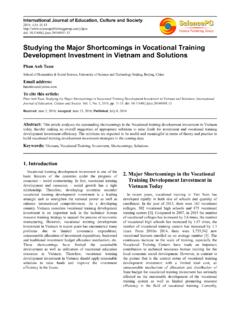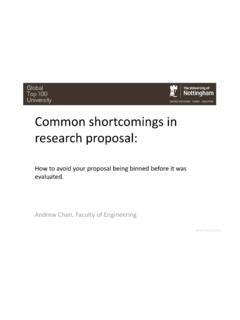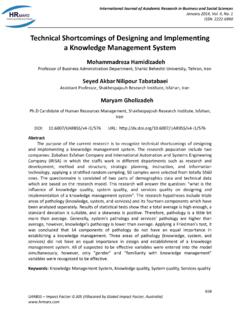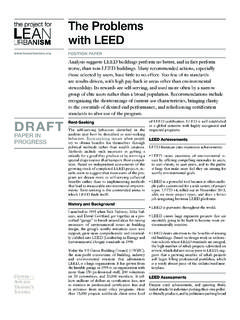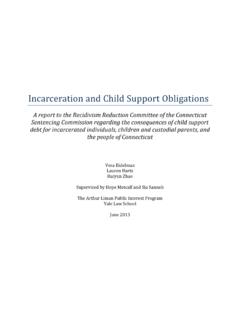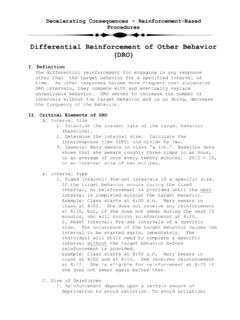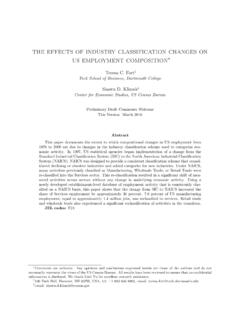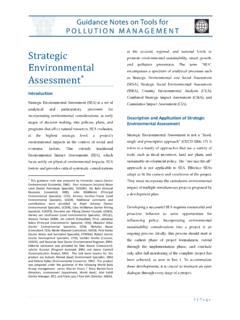Transcription of SHORTCOMINGS IN ENFORCING EU FOOD LAW. WHAT …
1 Lex Alimentaria food Law Office Headquarter: via Principe Umberto 2 73057 Taviano (LE), Italy. Tel.: +39 0833914727 // +39 3495849718 Bologna Office: via D Azeglio 27 40123 Bologna (BO), Italy Tel. +39 0516486188 E-Mail: 1 SHORTCOMINGS IN ENFORCING eu food law . WHAT DOES eu food law STAND FOR? FOREWORD One billion people live in chronic hunger and financial crisis is heavily hitting EU integration. We are still tempted to consider food under the sole perspective of safety and fair trade with minor attention to the negative externalities (wastes, unbalanced chain of value, bugs in transparency and information et cetera) which the illusion of an unlimited welfare hides thanks to mechanisms tolerated or allowed by legislators.
2 Public opinion in EU is not uniformly oriented to agree on suggestions that EU regulation is the best place to achieve consumer information and general belief that protection of national culinary traditions are weaker than (and not compatible with) a free-circulation based legal framework is increasing day-by-day. Additionally, foods consumed by Europeans are more and more a matter of international trade in agricultural, half-products and new foods from thirds countries. Despite all these important concerns, the present contribution will focus on some legal issues gathered from the Author s food Law Practice in an EU Member State with specific regard to interaction between EU rules on Hygiene and the enforcement at level of Member States.
3 It will contain a set of technical and legal considerations aimed at addressing some reflections and proposals to recovery SHORTCOMINGS arising from lack of certainty, misunderstandings, poor training, and contradictions between pieces of EU and National food Law. SUMMARY 1. eu food law : an introduction; 2. Modern eu food law and Challenges for Official Controls; 3. SHORTCOMINGS in defining eu food law Requirements; 4. Additional SHORTCOMINGS in achieving the claimed top level safety protection; 5. Shaded legal framework as regards consequences of lack of conformity; 6. Safe, complaint and not defective foods?; 7. Final remarks: seeking the key to enter the baroque cathedral.
4 1. eu food law : an introduction In general terms eu food law is a distinguished case of product-law as regulations on pharmaceuticals, cosmetics, toys, machineries et cetera are. However eu food law has a number of peculiarities the other product regulatory frameworks rarely have: the groundbreaking tool lies on the existence of a definition of food Law both at EU and Member State level: Nomen omen! Definition of food Law within EU Single Market is as follows: the laws, regulations and administrative provisions governing food in general, and food safety in particular, whether at Community or national level; it covers any stage of production, processing and distribution of food , Lex Alimentaria food Law Office Headquarter: via Principe Umberto 2 73057 Taviano (LE), Italy.
5 Tel.: +39 0833914727 // +39 3495849718 Bologna Office: via D Azeglio 27 40123 Bologna (BO), Italy Tel. +39 0516486188 E-Mail: 2and also of feed produced for, or fed to, food -producing animals .1 Two elements are clearly highlighted by the mentioned provision: i) food in general and ii) food safety in particular. Such a two-fold objective is confirmed by Article 5 of GFL according to which: food law shall pursue one or more of the general objectives of a high level of protection of human life and health and the protection of consumers' interests, including fair practices in food trade, taking account of, where appropriate, the protection of animal health and welfare, plant health and the environment (Article 5, par.
6 1, of GFL). It is important to bear in mind that such a definition applies to all legal acts or measures governing foodstuffs adopted at both the Community and national levels. Consequently, public authorities and private operators should pay attention to both elements: safety management and the other legal issues enclosed in the definition of food Law, namely: protection of consumers interests, fair practices and, where appropriate, the protection of animal health and welfare, plant health and the Secondly, eu food law is based upon general principles specifically governing the food market: risk analysis and precautionary principle, consumer protection and transparency.
7 Thirdly, the complex regulatory organization and the establishment of an Independent Authority play for an increased distinction of food (and feed) regulations from the other sister regulations. Fourthly, EU regulation on food calls for a more stringent integration within national systems for control of Since its very beginning, European legal acts in the domain of food trade called for more integration, mutual cooperation and assistance between public authorities. eu food law dates back to 1960s as veterinary activities in the EEC Commission were first formalised in 1963, when Directorate-General VI Agriculture established a new Directorate F Agricultural Legislation with Division in charge of harmonisation of the legislative, regulatory and administrative matters in the Member States.
8 The year before (1962) the plan for a Common Agricultural Policy 1 Article 3 of Regulation (EC) No 178/2002 of the European Parliament and of the Council of 28 January 2002 laying down the general principles and requirements of food law, establishing the European food Safety Authority and laying down procedures in matters of food safety. 2 Pisanello D., What do food Safety and Fair Trade stand for? Reconciling the twofold objective of eu food law , European food and Feed Law Review, 5/2009 and Van der Meulen B., The Function of food Law, On the objectives of food law, legitimate factors and interests taken into account, food and Feed Law Review 2/2010.
9 3 It is to be noted that the mentioned features are given in respect of pharmaceutical, from one side, and substances covered by REACH as well, but a lower level of integration in respect of food Law. Lex Alimentaria food Law Office Headquarter: via Principe Umberto 2 73057 Taviano (LE), Italy. Tel.: +39 0833914727 // +39 3495849718 Bologna Office: via D Azeglio 27 40123 Bologna (BO), Italy Tel. +39 0516486188 E-Mail: 3was adopted. As the demand for fresh meat increased dramatically in Europe in the 1950s and 1960s it was decided to harmonise the veterinary requirements for trade in live cattle and swine and in fresh meat, between the Member States: in 1964 the Council adopted the Directive 64/432/EEC on animal health problems affecting intra-Community trade in bovine animals and swine and the Directive 64/433/EEC on health conditions for granting temporary and limited derogations from Community health rules on the production and marketing of fresh meat.
10 This piece of legislation harmonised veterinary legislation in the Member States based upon the following principles: the responsibility of the exporting Member State, the control procedure, the importance of certification, the safety clause. Its scope was partial harmonisation , the rules were limited to products traded between the Member Regulation (EC) No 178/2002 of the European Parliament and of the Council of 28 January 2002 laying down the general principles and requirements of food law, establishing the European food Safety Authority and laying down procedures in matters of food safety (hereinafter, also General food Law, GFL) gave rise to a number of innovations: i) general principles of food Law (Risk Analysis, Precautionary Principle, Protection of consumers interests and principles of transparency).
